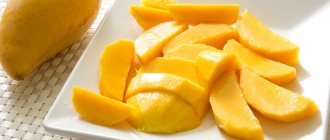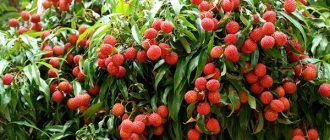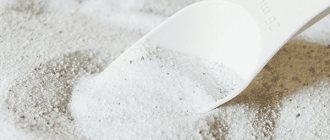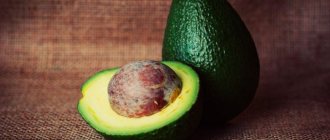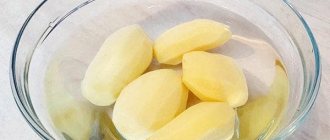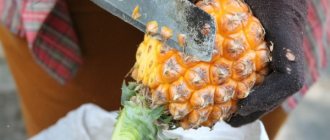general description
Lychee (lat. Litchi chinensis - Chinese plum) is a small sweet and sour berry covered with a crusty peel.
The fruit grows on evergreen tropical trees, the height of which reaches 10-30 meters. The birthplace of the berry is China. Lychee has an oval or round shape with a diameter of 2.5-4 cm. The ripe fruit has a dense red skin with a large number of sharp tubercles. Only the pulp of the fruit is used for food, which has a jelly-like structure, and in color and taste resembles peeled white grapes. Inside the pulp there is an oval brown seed. The main lychee harvest occurs in May-June.
History of appearance and distribution around the world
The first mention of lychee dates back to the 2nd century BC. during the reign of Chinese Emperor Wu Di. At that time, China was divided by the Great Wall of China into two separate states: South and North China. According to one legend, ruler Wu Di tried to introduce the fruit from the south and begin cultivating it in the northern territories, but due to lack of heat, moisture and soil fertility, the plant did not take root. Angry, he ordered the execution of all the court gardeners. Lychees were first brought to European countries in the mid-17th century.
Currently, lychee is grown everywhere throughout the subtropical territory of Southeast Asia, where there are no harsh winters and the climate is quite dry.
Use in cooking
Lychees are used mainly fresh for food. However, desserts (ice cream, jelly, marmalade), preserves, marmalade, and Chinese wine can also be made from the pulp of the berry. You can also find lychees in dried form. At the same time, the peel of the fruit becomes woody, and the dry pulp with the stone rolls freely inside. Lychee in this form is called lychee nut.
Selection and storage
Fresh fruits are very difficult to store and transport over long distances. To keep lychees longer, they are picked in clusters together with a branch and a few leaves. At a temperature of 1-7°C, lychees can be stored for a month, and at room temperature - only 3 days.
When purchasing lychees in a store, you should pay attention to the peel. It should be red, not too soft and without visible damage. The brown color indicates that the lychee is not fresh.
What is lychee, where and how does it grow?
This is a tropical evergreen tree. Reminiscent of willow, height 12-25 meters.
Lychee is native to the southern provinces of China, which is why it is known as the “Chinese plum.” But today the distribution area is the entire subtropical zone of the planet: Latin America, China, Indonesia, Vietnam, Thailand. From the last two regions, the fruit comes to Russia.
The fruits (also called lisi, liji, lyzhi, laysi, “dragon's eye”) are grouped in clusters. There are more than a hundred varieties. The exotic name begs the question: what does the fruit look like? Specimens are no larger than 35-40 mm and weigh 15-30 g (about the size of a plum). They are covered with a reddish crust with pointed pimples, which makes them look like raspberries. Inside there is whitish jelly pulp and a large brown seed.
The taste of fruits from different places differs - from sweet to sour. It depends on where the lychee grows and how much sun and moisture the tree gets while the fruit is ripening. Fruit harvesting times also vary. Usually this is May-August, in Thailand April-June.
But what is the correct way to say – lychees are berries or fruits? According to the botanical classification it is a berry, and at the culinary and everyday level it is a fruit.
Its main advantage is its ripening time. Lychee season is late spring and early summer, so there are no competitors.
Reviews
Elena, housewife, 40 years old . Today I bought lychees in our supermarket. This is already happening again. Last time I really liked the taste. But this time, the pulp was dry, tasteless and even with some bitterness, apparently it had been aged. Next time I will choose more carefully.
Valentin Nikolaevich, manager, 32 years old. I bought it for the first time after surgery - the doctor advised it. Since then I've been buying them as soon as they go on sale. I eat without restrictions and so far everything is fine. A kilogram lasts for three days, but the thing is very cool.
Lychee fruits deserve to take pride of place on your table. These berries are not only tasty, but also beneficial for the body, they improve the condition of internal organs, lift your spirits and charge you with energy.
How to eat lychees
The fruit looks exotic, but the process of consuming it is simple. Only the pulp of the fruit is edible. How to peel lychee? Simple: remove the skin from the washed fruit with a knife, picking it up from the tail. You can take a bite. Then they are separated into pieces by hand. The fruit pulp is cut in half and the pit is removed. On a ripe, high-quality specimen, the peel can be removed without any problems, and the pit can be easily separated.
The fruit is consumed in different forms:
- Fresh as a separate dish or an addition to fruit salads, desserts, ice cream, alcoholic or children's cocktails.
- The pulp of the fruit serves as the basis for sauces for meat, fish, and sweet syrups.
- Fresh or dried peels are added to tea as a flavoring agent.
- Preserved in sugar syrup.
- The whole fruit is dried, with the pit inside. The result is a lychee nut.
All methods, except the first, are used in the homeland of the fruit, in Southeast Asia. But they are gaining popularity in the countries where they are exported, including Russia.
You can treat yourself to the exotic Chinese drink kongou. This is a black leaf tea infused with lychee peel. Drink hot or chilled with ice cubes.
Choose exotic lychee fruits in the same way as ordinary ones. Signs of quality ripe fruits:
- Dense, elastic, without soft areas.
- The skin is shiny, intact, without cracks or tears. Overripe ones are dried out, faded, hardened.
- The skin color ranges from dark pink to purple. Brownishness appears in ancient, stale specimens. You should not buy green fruits - they will not ripen.
- The aroma is like a rose, spoiled ones have a cloying sweetness.
- The fruit pulp is tender, even watery.
The fruits are endowed with a sweet and sour taste, sometimes slightly viscous or tart. Connoisseurs compare it to grapes; some varieties are distinguished by flavor notes of mint, pineapple, raspberry, and strawberry. Or a mix of everything at once.
It is possible to preserve only fruits in clusters - with branches and stalks. At room temperature, the fruit remains fresh for no more than three days, in the refrigerator (2-7°C) - up to ten days. If you want to preserve it longer, you need to freeze, dry or preserve it. The Chinese claim that this does not impair the beneficial properties.
Is it possible to eat lychee seeds?
This part of lychee brings benefits and harm to health in equal measure. Lychees are eaten without the pit. The nucleoli are toxic, but are used in traditional medicine. Chinese healers dry them, calcinate them, and grind them into powder. Prescribed for gastrointestinal disorders or for the prevention of worms. The dosage is critically important, so self-medication in this way is excluded.
Use in cooking
Fresh lychee fruits are widely used in Asian cuisine. They are used:
- for the production of traditional wines, drinks and juices;
- as part of salads and various sauces for meat and fish dishes;
- as a filling for local pastries;
- for making ice cream, sorbets, fruit candies and other oriental desserts.
The berries make excellent cocktails, since their pulp has a high liquid content and an incomparable taste. Fresh berries are also crushed in a blender and added to fruit salads, ice cream and other dishes.
Chemical composition and calorie content
Lychee's beneficial properties are due to a complex composition of vitamins, macro- and microelements (g/100 g of pulp):
- Water – 78-83;
- carbohydrates (saccharides) – 14-15;
- proteins – 0.81;
- fats – 0.30;
- fiber – 1.49.
The fruits contain a large amount of vitamins that affect the basic functions of the body:
- B1, B2 – cellular metabolism.
- C – high concentration ensures growth, cell regeneration, strengthening of bones, nails, and hair. Helps with colds, bronchial asthma, tuberculosis.
- E – antioxidant.
- K – regulates blood clotting. The vitamin C content in lychee provides the body's daily requirement.
Essential microelements:
- Potassium – strengthens and heals the heart.
- Phosphorus - breaks down carbohydrates, builds and strengthens the skeleton, is necessary for fat metabolism, glucose absorption, and general metabolism.
- Calcium – strengthens the skeleton, nails, teeth, nerves, immunity. Promotes weight loss.
- Iron – normalizes metabolism.
- Sodium – improves the functioning of the genitourinary and digestive systems, prevents dehydration. “Organizes” intercellular metabolism.
- Zinc – removes toxins and heavy metals from the body, prolongs the youth of cells. Reduces stress and increases vigor. Beneficial for skin and hair.
- Selenium is antitumor, improves the functioning of the heart and thyroid gland. Prolongs youth.
- Manganese is essential for the functioning of the nervous system, brain, and thyroid gland. Regulates metabolism and blood sugar.
- Copper - improves blood quality, improves the endocrine system and gastrointestinal tract, strengthens the immune system. Supports the production of tyrosine, without which brain function is problematic.
- Nicotinic acid – ensures the functioning of the pancreas, gastrointestinal tract, liver, heart, blood vessels. Removes toxins, lowers blood sugar. Inhibits the appearance or development of atherosclerosis and senile dementia.
What makes lychee unique in terms of health benefits is the combination of potassium, copper, ascorbic and nicotinic acids.
Carbohydrates give the fruit its sweetness. But the ripe lychee fruit contains only 65 - 75 units of calories per 100 grams. It depends on the type of fruit.
Peculiarities
Litchi chinensis belongs to the Sapindaceae family. The trees have beautiful small leaves that are bright green. The fruits ripen in clusters, while the berries do not have petals; they have the shape of cups with umbrella-shaped inflorescences. They reach up to 3.5 cm in size. They resemble strawberries in appearance.
The flesh is creamy or white. The taste is reminiscent of grapes, but with an astringent taste. The peel has small thorns. The ripening period is from the beginning of May to the end of June. The pulp cannot be consumed at the same time as the seeds, and the peel of the fruit is used in the preparation of some dishes.
Exotic berries came to European countries in the 15th century, thanks to the Spaniard Juan Gonzalez de Mendoza. The unusual product aroused increased interest and gradually spread to other countries.
Beneficial features
Even the ancient Chinese found out that the whole body benefits from the lychee fruit. Adherents of traditional medicine have studied the benefits of lychee fruits and use them for many problems:
- dysfunction of the liver, kidneys;
- high cholesterol;
- threat or initial stages of atherosclerosis;
- asthma, bronchitis, diabetes, tuberculosis;
- emotional breakdowns (depression, neuroses);
- fatigue, anemia, anemia, weakened immunity;
- increased physical activity.
Extracts, essential oils, decoctions, and dietary supplements are made from the fruit. The most striking example is the Japanese dietary supplement “Oligonol”. Created on the basis of the polyphenol of the same name, which is rich in lychee. It removes free radicals that age the body and reduce immunity.
The fruit has been widely used by cosmetologists as an effective tool in solving skin problems (flabbiness, rashes, acne) and hair.
Strengthens immunity
The daily intake of fruit supplies a person with the optimal amount of copper and ascorbic acid. As a result, the immune system is “perked up”, stimulating the body to produce white blood cells. They are the ones who put up a shield for illnesses.
Chinese scientists have found that regular consumption of lychee strengthens the body's resistance to stress.
Improves digestion
The fruit affects the body in two ways. The fibrous structure plus the high concentration of carbohydrates improves digestion and motility of intestinal smooth muscles. At the same time, the production of gastric juice is stimulated, which improves the absorption of nutrients. Therefore, the fruits are indicated for intestinal problems (primarily constipation).
Blood pressure control
Overseas lychee fruits are useful for hypertensive patients. Potassium removes excess sodium and water from the body. At the same time, the heart rate, which is often elevated in patients, is normalized.
Lychee benefits for weight loss
The fruit is almost pure water, with a minimum of fat. It is low in calories, but kills hunger for a long time, and has a diuretic effect.
This property makes it an ideal ally in the fight against excess weight.
Antitumor effect
The medicinal qualities of the fruit are irreplaceable as prevention and in the initial stages of oncology. We are talking about powerful antioxidant polyphenols that inhibit the development of malignant tumors.
Aphrodisiac
The sorcerers of Hindustan have been making potions (including love spells) from the fruit for centuries. Not much has changed today.
Residents of Southeast Asia attribute lychee aphrodisiac properties. Its unofficial name is “fruit of love.”
Doctors have found that a decoction of the skin of the fruit strengthens male potency. The Chinese make wine from it, which “stimulates the soul and awakens love.”
Hundreds of tourists come to the Thai Lychee Festival. The colorful event is timed to coincide with the harvest. Every Thai beauty dreams of becoming Miss Lychee by winning a beauty pageant.
Contraindications
Hardly ever. They can be harmful only if you are individually intolerant. However, you need to know that you shouldn’t eat too much of them. For adults, 200-250 grams per day is enough. For children, it is better to reduce this norm to 100 grams. Otherwise, some may experience allergic reactions in the form of acne on the skin or on the oral mucosa.
What are the benefits of lychee for the female body?
For ladies, the benefits of lychee fruit are multifaceted. Each element is involved:
- Pectin – breaks down fats, promoting weight loss. Rejuvenates the body as a whole.
- Nicotinic acid is responsible for the beauty and health of hair.
- Calcium is indicated for women whose family has a tendency to osteoporosis, a series of births, and early chronic diseases. As a preventive measure, it is useful for everyone who works in difficult or unfavorable climatic or production conditions. Especially those over 30.
Lychee contains substances that solve purely women's problems:
- Vitamins C and E are essential for women on the eve of menopause.
- B vitamins (1, 6) – indicated for menopause.
- Magnesium is a salvation during menopause. Normalizes blood quality, lowers cholesterol.
- Copper is indispensable in the production of female sex hormones.
In addition, the listed elements improve the emotional state, improve sleep, performance, and skin condition.
Is it possible for pregnant women and breastfeeding
There is no consensus in the medical community about the effects of lychee during pregnancy. Nutritionists are in favor, gynecologists are more cautious.
Everyone agrees: berries have diuretic properties, so they are useful for swelling. Only exceeding the daily dose (maximum ten berries) is dangerous.
The fruit is useful for nursing mothers. It is rich in nicotinic acid, which enhances lactation. But you can eat it at least half an hour - forty minutes before feeding and no more than five berries per day. Consultation with a doctor is required.
What should a ripe fruit look like?
Those fruits that have the following characteristics are considered high-quality and fresh:
- uniform bright red color;
- whole cover without damage or stains;
- elastic, but not rigid structure;
- pleasant aroma of rose petal jam;
- not separated stalk and branch;
- sound from moving the bone when shaking.
The greenish color of the lychee indicates the immaturity of the specimen. It is not recommended to buy unripe fruits as they cause severe stomach upset.
The skin of an unripe fruit is green.
ethnoscience
Since the fruits are so beneficial, traditional healers use them to prepare potions. After all, it is believed that lychee can relieve pain, protect the body from infections and viruses, and strengthen the immune system. The ability to reduce bad cholesterol levels and maintain heart and vascular health is also emphasized.
For example, an infusion made from the peel is popular. This drink is prepared as follows: take a tablespoon of chopped fruit per glass of boiling water. Let it sit for a quarter of an hour and strain. You should drink before your first meal and in the evening, before dinner. This infusion improves body tone and helps avoid neuroses.
You can prepare a decoction from the seeds; this remedy, according to healers, helps with nervous diseases. How the decoction is made: the bones, previously washed and dried, are crushed and then brewed with boiling water. Seed infusions are also recommended for intestinal diseases. This decoction can relieve stomach cramps.
It is recommended to eat the fruits fresh, with the peel removed. They should be eaten if:
- There are problems with the heart and blood vessels.
- Increased cholesterol levels.
- I suffer from constipation and poor bowel function.
- The body is weakened.
- There is diabetes, and lychees have a low glycemic index.
- I have a stomach ulcer.
- There are problems with the kidneys and liver.
- There are problems with the pancreas.
- Cancer prevention is needed.
- Enlarged lymph nodes.
Even the flowers and roots of the plant are used for medicinal purposes - they are brewed for gargling. A tincture is also prepared from the flowers, which can help with sun dermatitis.
Papaya fruit: beneficial properties and harm
Youth elixir
What should we cook from lychee? Let's start with a light milkshake. In addition to the lychee itself, it contains raspberries. This duet is a real antioxidant bomb. This drink satisfies well, suppresses hunger and helps remove all excess from the body. This combination also tones the skin well and improves complexion.
Ingredients:
- lychee pulp - 50 g
- raspberry syrup - 2-3 tbsp. l.
- milk 6% - 120 ml
- vanilla sugar - 1 tsp.
- mint and fresh raspberries - for decoration
Beat the lychee pulp into a puree. Add sugar to the milk and beat lightly with a whisk until it completely dissolves. Add lychee puree here and mix well. Pour raspberry syrup into the bottom of the glass, carefully add milk and lychee puree on top. Place ice cubes and place raspberries between them. Garnish the cocktail with mint leaves and serve immediately.
Benefits for pregnant women
The body of the expectant mother needs a large amount of useful substances. The main benefit for expectant mothers is its high folic acid content. Pregnant women and women planning pregnancy are prescribed folic acid without fail. The vitamin is important for the growth and development of the baby’s circulatory system, and its regular consumption reduces the risk of neural tube defects in the baby.
Potassium has incredible benefits for the expectant mother; it normalizes the intercellular movement of fluid, relieving the woman of painful swelling. Copper contained in lychee berries is necessary for the formation of red blood cells. Regular consumption of fruits will prevent the development of hypoxia in the fetus. The pleasant sweet and sour taste will help the expectant mother cope with toxicosis. Fiber will help relieve constipation. The expectant mother should familiarize herself with the peculiarities of consuming lychee berries in such a way as not to harm herself and her baby.
Pink dream
If desired, you can make an exquisite dessert from Chinese plums - cakes with lychee mousse. Let's take a regular sponge cake as a basis, and use white and colored mousse as a layer. It will turn out delicious and elegant.
Biscuit ingredients:
- chicken eggs - 4 pcs.
- sugar - 175 g
- flour - 140 g
- vanillin - on the tip of a knife
Mousse:
- lychee – 300 g
- raspberries - 150 g
- gelatin - 20 g
- water – 70 ml
- sugar - 50 g
- egg yolks - 3 pcs.
- milk - 400 ml
- cream - 400 ml
Raspberry jelly:
- raspberries - 100 g
- gelatin - 5 g
- water - 30 ml
- sugar - 2 tbsp. l.
- lemon juice - 1 tsp.
First we make sponge cakes. Beat 4 eggs with sugar until a thick, light mass is formed. Gradually add flour and knead the dough. Pour it into a tall square mold and place in the oven at 180°C for 30–40 minutes. When the cake has cooled, carefully cut it lengthwise into two equal parts.
While the sponge cake is baking, make the mousse. Soak gelatin in water. Beat the yolks with sugar and heat in a small saucepan. Add warm milk and swollen gelatin, dissolve well. Pour about a third of the mass into another pan. Add 150 g raspberry puree into the first pan. The mousse will turn out pale pink. In the second pan the mousse will remain white. For jelly, soak gelatin in 1 tbsp. l. water. Grind the raspberries into a puree, add the remaining water, lemon juice and sugar. Place the mixture in a saucepan over low heat and cook until thickened.
Now let's move on to assembly. Place the first cake layer in a rectangular pan, coat it with pink mousse, place the second cake layer and also coat it with pink mousse. Place the mixture in the refrigerator to allow the mousse to harden. Then we grease it with white mousse and put it in the cold again. Finally, fill everything with raspberry jelly and leave it in the refrigerator for a couple of hours. Cut the dessert into portions and decorate as you wish.
Storage
Lychee is high in sugar, making it a quick-to-eat fruit. In order not to lose the beneficial properties of lychee fruit, they can be stored without removing the skin for no more than three days, and if frozen, they will last for several months.
But the skin must first be removed. If stored for a long time, the medicinal properties may be lost.
Vitamins
| Vitamins | Quantity | Norm |
| Vitamin B1 | 0.011 mg | 1.5 mg |
| Vitamin B2 | 0.065 mg | 1.8 mg |
| Vitamin B4 | 7.1 mg | 500 mg |
| Vitamin B6 | 0.1 mg | 2 mg |
| Vitamin B9 | 14 mcg | 400 mcg |
| Vitamin C | 71.5 mg | 90 mg |
| Vitamin E | 0.07 mg | 15 mg |
| Vitamin K | 0.4 mcg | 120 mcg |
| Vitamin PP | 0.603 mg | 20 mg |
